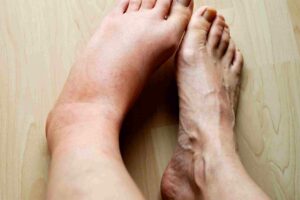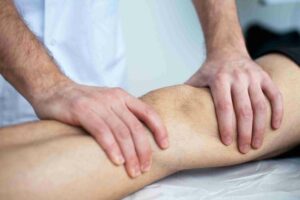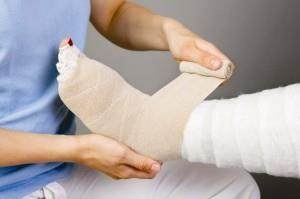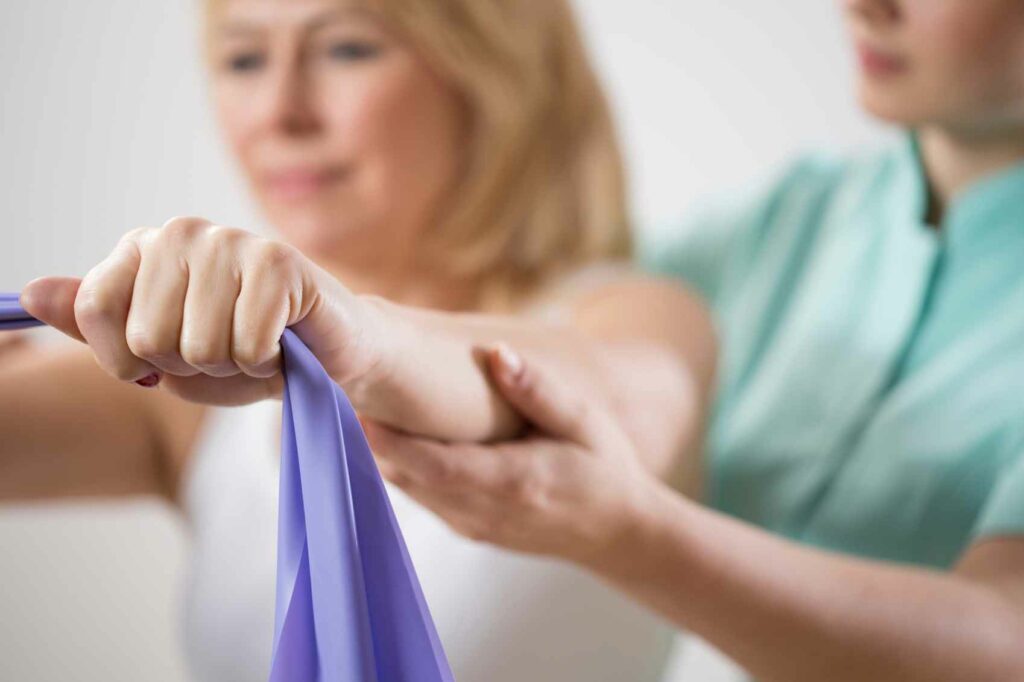If you have been diagnosed with lymphedema, you may be wondering what your treatment options are. Lymphedema physical therapy is one of the most common treatments for this condition. In this guide, we will discuss the benefits of lymphedema physical therapy and how it can help improve your quality of life. We will also provide a step-by-step guide on how to get started with this treatment regimen.
Contents
What Is Lymphedema?

Lymphedema is an abnormal accumulation of lymphatic fluid in the tissues. It usually affects a limb (arm or leg) but can also affect other parts of the body, such as the face and neck.
This condition most commonly occurs following surgery to remove tumors located under the arm or in the chest that has caused damage to the lymphatic system. Lymphedema can also be caused by certain genetic conditions and certain infections, such as filariasis or mastitis.
Lymphedema is graded according to severity: mild (grade 1 lymphedema), moderate (grade 2 lymphedema), or severe (grade 3 lymphedema).
It is a chronic condition that often requires ongoing care. Treatments may include: compression garments, regular manual lymphatic drainage massage, exercise to improve arm and leg strength, and avoidance of activities or circumstances that might further damage the lymphatic system.
Diagnosis For Lymphedema
If you have severe lymphedema, a doctor can give you a proper diagnosis. Severe lymphedema is when the affected limb swells up quite significantly over time and cannot be put back to normal through home care measures or any other method. If such a situation arises, it is best to get immediate treatment in order to eliminate the threat in the long run.
Different Types Of Physical Therapy For Lymphedema
There are many options for physical therapy treatment for lymphedema:
Manual Lymphatic Drainage
 The first type of physical therapy is manual lymphatic drainage. This technique uses gentle massage to help move the lymph fluid through the body and reduce swelling in the affected areas. Manual lymphatic drainage can be performed by a trained therapist or at home with self-massage techniques.
The first type of physical therapy is manual lymphatic drainage. This technique uses gentle massage to help move the lymph fluid through the body and reduce swelling in the affected areas. Manual lymphatic drainage can be performed by a trained therapist or at home with self-massage techniques.
Compression Bandage
 The second type of physical therapy treatment for lymphedema is compression bandaging. This technique involves wrapping the affected areas with specialized bandages to help squeeze the lymph fluid out of the tissues. Compression bandaging may be used on its own or in combination with other therapies, such as manual lymphatic drainage and exercise.
The second type of physical therapy treatment for lymphedema is compression bandaging. This technique involves wrapping the affected areas with specialized bandages to help squeeze the lymph fluid out of the tissues. Compression bandaging may be used on its own or in combination with other therapies, such as manual lymphatic drainage and exercise.
Exercise
 Finally, another option for lymphedema physical therapy is exercise. Exercise can help improve muscle strength and promote circulation in the affected areas, which can reduce swelling and improve overall health. Whether you are performing exercises at home or working with a therapist, there are many different types of exercises that may be helpful for lymphedema patients.
Finally, another option for lymphedema physical therapy is exercise. Exercise can help improve muscle strength and promote circulation in the affected areas, which can reduce swelling and improve overall health. Whether you are performing exercises at home or working with a therapist, there are many different types of exercises that may be helpful for lymphedema patients.
If you are looking for effective physical therapy treatment for lymphedema, it is important to work with a qualified healthcare provider who can help recommend the right options for your needs. With the right techniques and guidance, you can find relief from your symptoms and improve your overall health and well-being.
What Does A Lymphedema Therapy Consist Of?
Lymphedema physical therapy should be started as soon as possible after a diagnosis of lymphedema is made. This will help prevent further swelling and keep the damage from worsening. However, it is best to consult your doctor first before any physical therapy treatment for lymphedema. Your doctor will know what type of physical therapy is the most appropriate and whether your body is fit enough to undergo such therapy.
A typical lymphedema session will include a combination of gentle massages, bandaging, exercises and other therapies that can help improve your lymphedema symptoms. Lymphatic massage is used to keep the swelling under control and make sure that your lymph fluid can flow efficiently through the body. Manual lymph drainage, another type of manual massage, gently stretches and works on the skin to encourage better lymph flow. Bandaging is important for patients who have swollen limbs and it helps to exert pressure on the swollen area so that it does not get any worse than it already is.
Tips To Keep In Mind When Finding Lymphedema Therapy Near You

Lymphedema is a condition that can greatly affect the way a person lives. Getting help for it is crucial to preventing further problems and improving your quality of life. This article will discuss some tips to keep in mind when finding lymphedema therapy near you, so pay close attention.
Tip 1: Do Your Research
One of the first things that you should do when looking for lymphedema therapy near you is to do your research. This will include:
- Gathering information from websites,
- Reading reviews
- Talking to friends and family members about the services they have received in the past.
The more information you gather, the more informed you can be about what your treatment options are.
Tip 2: Consider What You Need
Figuring out what you need from lymphedema physical therapy treatment is key to finding the right provider. Think about what you are looking for in terms of services, location, and budget. Besides this, you also want to consider things like whether or not your health insurance will cover the treatment or if there are any limitations.
Tip 3: Talk to Your Doctor
Speaking with your doctor can help you figure out what your next step should be when it comes to finding the right lymphedema physical therapy treatment for you. They may be able to recommend a particular provider or they may offer information on different providers in the area and their services and specialities.
Tip 4: Consider Referrals
Asking for referrals can also be a great way to find the right provider. If you know someone who has received lymphedema therapy in the past, you can talk to them about their experience. Whether or not they would also recommend the centre. With that said, make sure to do your own research on any potential providers as well so that you can confirm that the therapy they received was the best for them.
Tip 5: Ask Questions
Once you have narrowed down your choices, make sure to ask about their services. Tell them what you expect from treatment. This is a great way to get to know whether or not it will be a good fit for you in terms of your financial, physical, and emotional needs. The more questions you ask the better off you will be when it comes to finding lymphedema therapy that is right for you.
Tip 6: Consider Your Budget
Obviously, pricing is something to think about when it comes to choosing a provider of lymphedema physical therapy treatment. Some people may be able to afford a high-end provider, but many people cannot. Consider your financial situation and whether or not you need any type of assistance paying for care.
After doing all of these things, it is best to call the company directly and get started with treatment.
Conclusion
In conclusion, the treatment guide to lymphedema physical therapy can be a great asset to a person with this condition. By following the tips and techniques outlined above, you can minimize any adverse effects. Use these tools every day as part of your treatment plan. These tips and tricks will you keep healthy and active!
Physical Therapy help patients recover from pain. If you’re experiencing Back pain, Shoulder pain, Knee pain, Neck pain, Elbow pain, Hip pain, or Arthritis pain, a physical therapist at MantraCare can help: Book a physiotherapy session.


